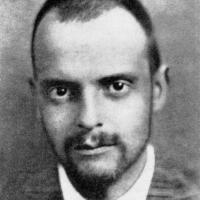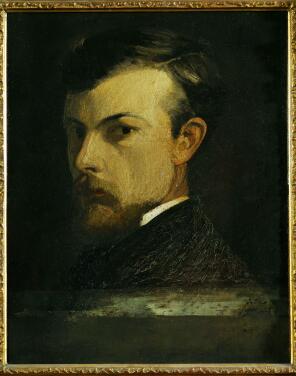S otheby's 2020 Art Impressionniste et Moderne sale in Paris presents major works by Paul Klee and René Magritte, a monumental bronze by Rembrandt Bugatti and a stunning floral composition by Odilon Redon. Surrealist works by Francis Picabia, including two oils that were in the mythical collection of Gertrude Stein, also feature in the sale.
Kept in the same private collection for the last 60 years, Abend in N (Evening in N) or Architektur abends (Architecture in the Evening), is a remarkable work by Paul Klee dating from 1937. Painted in nocturnal tones, the composition is emblematic of the artist’s technique based on subtle associations of geometric shapes and colours. Incredibly, the work has been extremely well-preserved since its execution. It has been exhibited in the world’s most prestigious museums since it was painted, reflecting its status within Klee’s oeuvre.
Le Temps jadis is a silent scene captured at dusk, which reflects Magritte’s fascination throughout his career with the apparent opposition between reality and illusion. Completed a year before the artist’s death, while he was at the peak of his career, the piece combines the key elements of his pictorial vocabulary, such as fire, the raven and the bilboquet. Painted with the powerful simplicity that characterised his last works, Le Temps jadis has an atmosphere of spellbinding mystery.
The sale will feature an important selection of sculptures, the centrepiece being a monumental bronze by Rembrandt Bugatti, Tigre de Sibérie. At almost three metres long, this masterly feline is life-sized. With extraordinary skill, the sculptor has brought out the tiger’s impressive musculature and powerful weight, suggesting its breathing as it advances. Only a few rare examples of this model were cast, one of which can be seen in Antwerp Zoo. This is the first time an edition of this spectacular model has been presented at auction.
German Expressionist painter Emil Nolde is represented in this sale with a composition from 1918 depicting a sea of coloured clouds, Wolken. Inspired by the artist’s sojourn on the North Sea coast, this piece blazes with rich colours and striking contrasts.
Gertrude Stein and Francis Picabia first met in 1913. However, it was not until years later, in the late 1920s, that they really became friends. Until the end of her life, Gertrude Stein championed her friend Picabia's art, writing numerous prefaces to his exhibitions. It is interesting to note that Ida, is also the title of a novel by Gertrude Stein, which she began in 1928 and published in 1941. Picabia gave two of his Transparencies this title, most likely echoing the literary work his friend was working on in parallel: the painting shown here and another version made in 1932. Both versions belonged to Gertrude Stein.
Painted in the early 1940s, this head-and-shoulders portrait of a woman against a blue background is absolutely representative of Picabia's 'realistic' period. This work attests to the audacity of Francis Picabia's compositional approach. Although the 1940s portraits seem more academic than his earlier works, Picabia shows that he is avant-garde, no matter what. He thus reinvents the genre of portraiture through the close-up framing of the woman's face and through the use of bright light which shapes the model's features the way a film studio would, opening the door to Pop Art.
The town of Vence is a major southern locale in Raoul Dufy's Cezanne-like studies. This landscape, painted circa 1923, belongs to a series of works created between 1919 and 1923. Of all the variations that exist on this theme, this painting is one of the most accomplished pieces. Dufy separates the colour from the outline of the shapes; the forms thus attain a sense of autonomy and become even more expressive. Moreover, he adapts to the intense bright light of the South of France, redistributing it into patches of colour.
This 1948 work, painted ten years after he lost an eye, is emblematic of Victor Brauner's interest in non-European cultures. The artist freely interprets cultures and myths, thus creating a universe of his own. In this work, he summons the figure of Janus — a two-faced Roman god, symbolizing both beginnings and endings as well as the connection between the conscious and subconscious — in a syncretic way. In this work, reality gives way to a fantastic, poetic world, executed in a style combining an effusion of colours with a rejection of the third dimension.
More than 70 years after it was confiscated by the Nazi regime, this remarkable painting by Odilon Redon, Vase de fleurs, was recently returned to its rightful owners. It was originally part of the collection belonging to Georges Lévy (1899-1943), the head of a brokerage firm. The proceeds of the painting’s sale will go to charity.
This beautiful, skilfully carved cast made in 1905 by Eugène Blot represents the famous Implorante. The kneeling young woman was originally part of the L'Âge Mûr ['The Mature Age'] group that Camille Claudel created for a commission she received through Auguste Rodin from the Director of the École des Beaux-Arts in 1899. In fact, Claudel created this work after separating from the sculptor whom she had met in 1883. It is accepted that the Implorante represents Camille herself trying to hold on to her illustrious lover.



























